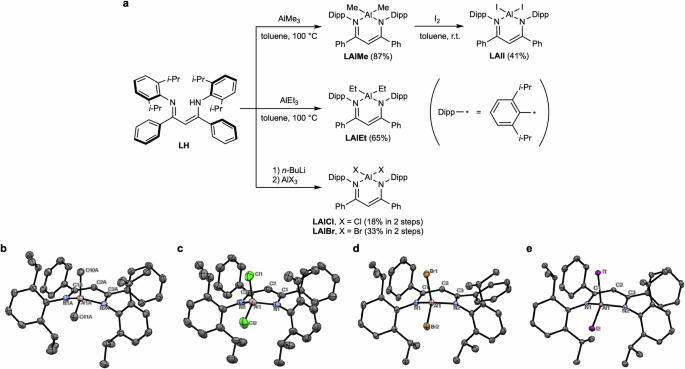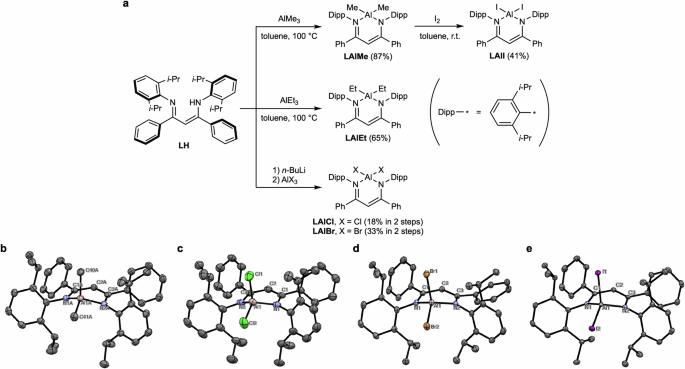通过调整金属取代基调节铝络合物的光致发光,使其从非发光状态转变为室温磷光状态
IF 5.9
2区 化学
Q1 CHEMISTRY, MULTIDISCIPLINARY
引用次数: 0
摘要
尽管发光铝化合物已被用于有机发光二极管中的发射层和电子传输层,但由于浓度淬灭的原因,大多数铝化合物在聚集态下通常不显示磷光,而是显示荧光,其光量子产率低于非晶态下的光量子产率。在这里,我们展示了 β-二偏亚铝络合物的合成、结晶诱导发射(CIE)和室温磷光(RTP)等光学性质,以及中心元素的取代基效应。研究发现,二卤铝络合物具有 CIE 特性,尤其是二碘络合物的 RTP,而二烷基络合物在溶液和固体状态下几乎没有发射。理论计算表明,应通过引入电负性卤素而不是烷基来抑制二烷基配合物单子激发态中不希望出现的结构弛豫。我们的发现不仅可以为获得发光复合物提供分子设计,还可以为实现三重收集材料提供分子设计。发光铝化合物已被用于有机发光二极管中的发光层和电子传输层,但大多数都表现出荧光而非磷光。这里的研究表明,β-二亚基铝配合物的光物理特性取决于金属取代基的性质,其中一种二碘铝配合物显示出室温磷光。本文章由计算机程序翻译,如有差异,请以英文原文为准。


Regulating the photoluminescence of aluminium complexes from non-luminescence to room-temperature phosphorescence by tuning the metal substituents
Although luminescent aluminum compounds have been utilized for emitting and electron transporting layers in organic light-emitting diodes, most of them often exhibit not phosphorescence but fluorescence with lower photoluminescent quantum yields in the aggregated state than those in the amorphous state due to concentration quenching. Here we show the synthesis and optical properties of β-diketiminate aluminum complexes, such as crystallization-induced emission (CIE) and room-temperature phosphorescence (RTP), and the substituent effects of the central element. The dihaloaluminum complexes were found to exhibit the CIE property, especially RTP from the diiodo complex, while the dialkyl ones showed almost no emission in both solution and solid states. Theoretical calculations suggested that undesired structural relaxation in the singlet excited state of dialkyl complexes should be suppressed by introducing electronegative halogens instead of alkyl groups. Our findings could provide a molecular design not only for obtaining luminescent complexes but also for achieving triplet-harvesting materials. Luminescent aluminum compounds have been utilized for emitting and electron transporting layers in organic light-emitting diodes, but most exhibit fluorescence as opposed to phosphorescence. Here, the photophysical properties of β-diketiminate aluminum complexes are shown to depend on the nature of the metal substituents, with a diiodoaluminum complex displaying room temperature phosphorescence.
求助全文
通过发布文献求助,成功后即可免费获取论文全文。
去求助
来源期刊

Communications Chemistry
Chemistry-General Chemistry
CiteScore
7.70
自引率
1.70%
发文量
146
审稿时长
13 weeks
期刊介绍:
Communications Chemistry is an open access journal from Nature Research publishing high-quality research, reviews and commentary in all areas of the chemical sciences. Research papers published by the journal represent significant advances bringing new chemical insight to a specialized area of research. We also aim to provide a community forum for issues of importance to all chemists, regardless of sub-discipline.
 求助内容:
求助内容: 应助结果提醒方式:
应助结果提醒方式:


